

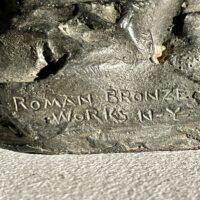
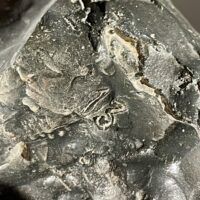
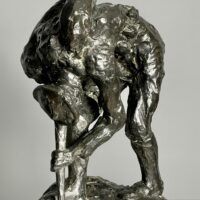
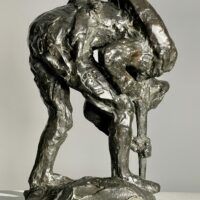
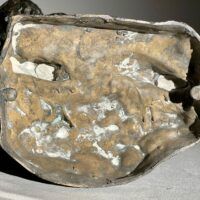
Gertrude Vanderbilt Whitney
American, 1875-1942
Still At His Post, circa 1919
Bronze, dark brown patina
14 ⅜ H. x 10 ¼ W. x 9 D. inches
Signed on base: Gertrude V Whitney / NY
Numbered on base: 13
Inscribed on base:
ROMAN BRONZE / WORKS N – Y –
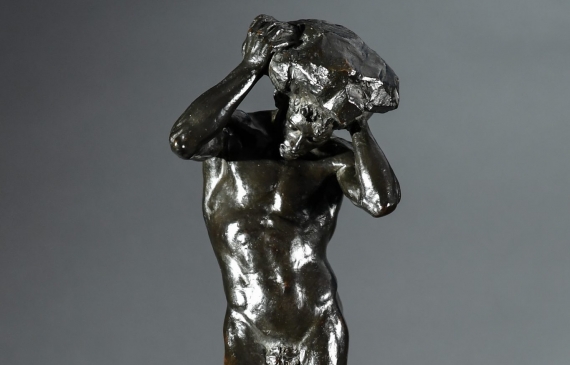
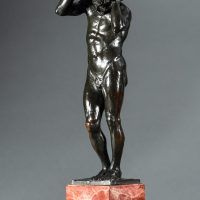
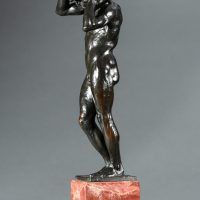
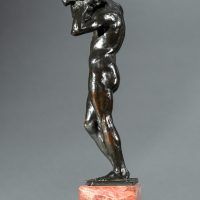
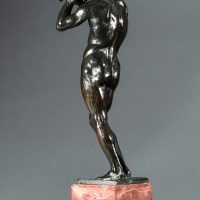
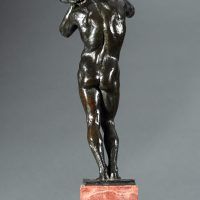
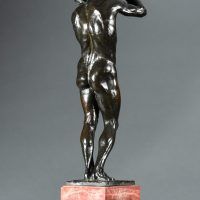
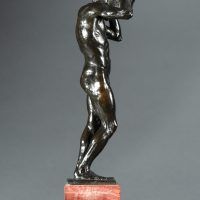
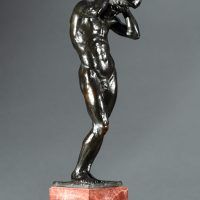
Gertrude Vanderbilt Whitney
American, 1875-1942
Caryatid, modeled 1912; cast 1915
Bronze, brown patina
19 H. x 6 ½ W. 6 ⅜ D. inches
Signed on base: Gertrude V. Whitney / © 1915
Stamped on base: C.Valsuani / Cire Perdue
Mounted on original rouge marble base: 4 ⅛ H. x 5 ¾ Square

Gertrude Vanderbilt Whitney
American, 1875-1942
Spanish Peasant, 1913
Bronze, dark brown patina
9 ¾ H. x 7 ½ W. x 7 ¼ D. inches
Mounted to period marble base: 4 ⅜ H. inches
Total height: 14 ⅛ inches
Signed and dated verso: © Gertrude V. Whitney / 1913
Stamped verso: Cire Perdue / C. Valsuani (Paris)
Gertrude Vanderbilt was born on January 9, 1875 in New York City, the second daughter of Cornelius Vanderbilt II (1843–1899) and Alice Claypoole Gwynne (1852–1934), and a great-granddaughter of “Commodore” Cornelius Vanderbilt. Her older sister died before Gertrude was born, but she grew up with several brothers and a younger sister. The family’s New York City home was an opulent mansion at 742–748 Fifth Avenue. As a young girl, Gertrude spent her summers in Newport, Rhode Island, at the family’s summer home, The Breakers, where she kept up with the boys in all their rigorous sporting activities. She was educated by private tutors and at the exclusive Brearley School for women students in New York City. She kept small drawings and watercolor paintings in her personal journals which were her first signs of being interested in the arts.
While visiting Europe in the early 1900s, Gertrude Whitney discovered the burgeoning art world of Montmartre and Montparnasse in France. What she saw encouraged her to pursue her creativity and become a sculptor.
She studied at the Art Students League of New York with Hendrik Christian Andersen and James Earle Fraser. Other women students in her classes included Anna Vaughn Hyatt and Malvina Hoffman. In Paris she studied with Andrew O’Connor and also received criticism from Auguste Rodin in Paris. Her training with sculptors of public monuments influenced her later direction. Although her catalogs include numerous smaller sculptures, she is best known today for her monumental works.
Her first public commission was Aspiration, a life-size male nude in plaster, which appeared outside the New York State Building at the Pan-American Exposition in Buffalo, New York, in 1901. Initially she worked under an assumed name, fearing that she would be portrayed as a socialite and her work not taken seriously. Neither her family nor (after her marriage) her husband were supportive of her desire to work seriously as an artist. She once told an artist friend, “Never expect Harry to take your work seriously… It never has made any difference to him that I feel as I do about art and it never will (except as a source of annoyance).” She believed that a man would have been taken more seriously as an artist, and that her wealth put her in a lose-lose situation: criticized if she took commissions because other artists were more needy, but blamed for undercutting the market for other artists if she was not paid.
In 1907, Whitney established an apartment and studio in Greenwich Village. She also set up a studio in Passy, a fashionable Parisian neighborhood in the XVI arrondissement.
By 1910 she was exhibiting her work publicly under her own name. Paganisme Immortel, a statue of a young girl sitting on a rock, with outstretched arms, next to a male figure, was shown at the 1910 National Academy of Design. Spanish Peasant was accepted at the Paris Salon in 1911, and Aztec Fountain was awarded a bronze medal in 1915 at the San Francisco Exhibition. Her first solo show occurred in New York City in 1916. The first charity exhibition she organized was in 1914 called the 50-50 Art Sale.